Tóm tắt Luận án Nghiên cứu nồng độ leptin, adiponectin huyết tương và tỷ leptin / adiponectin trên đối tượng thừa cân - Béo phì
Leptin là một trong những adipokin được phát hiện đầu tiên
của mô mỡ và khẳng định vai trò quan trọng của mô mỡ là một cơ
quan nội tiết. Leptin giúp điều hòa sự trao đổi chất trong cơ thể bằng
cách kích thích sự tiêu hao năng lượng, ức chế ăn vào. Trong hầu hết
các trường hợp béo phì, tình trạng đề kháng leptin biểu hiện ở sự gia
tăng nồng độ leptin huyết tương đã làm giới hạn hiệu quả sinh học
của nó. Trái ngược với leptin, sự tiết adiponectin thường bị suy giảm
trong béo phì. Adiponectin làm tăng sự nhạy cảm với insulin, oxy
hóa acid béo cũng như tiêu hao năng lượng và làm giảm lượng
glucose trong gan. Đây là hai sản phẩm bài tiết quan trọng của mô
mỡ có vai trò gần như đối lập nhau. Adiponectin là chất bảo vệ còn
leptin có tác dụng tấn công. Biến đổi nồng độ của 2 chỉ số trên đều liên
quan với một số yếu tố nguy cơ tim mạch, chuyển hóa. Chính vì vậy
khảo sát nồng độ leptin, adiponectin ở bệnh nhân thừa cân, béo phì là
đề tài có cơ sở khoa học và lý luận chuyên ngành, một hướng nghiên
cứu mới đang được quan tâm
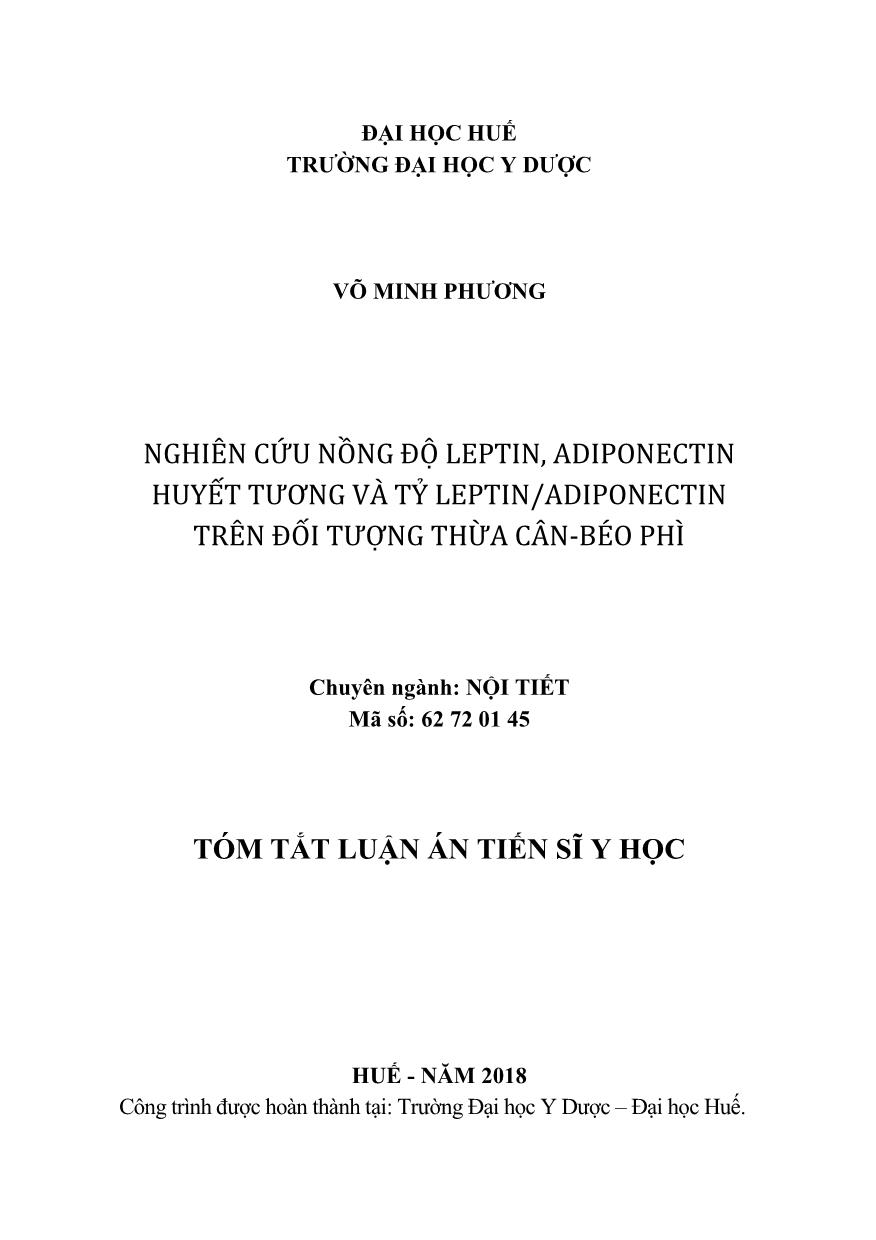
Trang 1

Trang 2
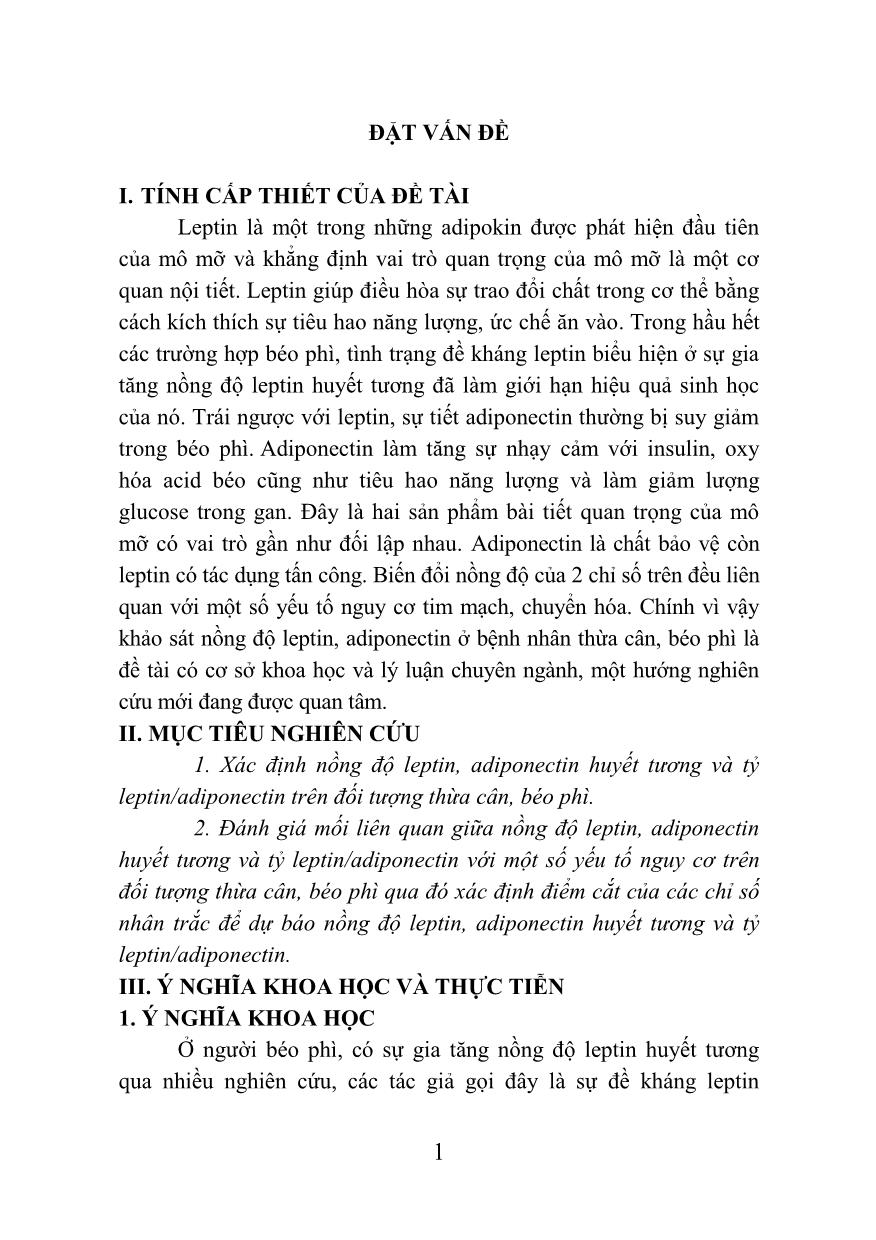
Trang 3
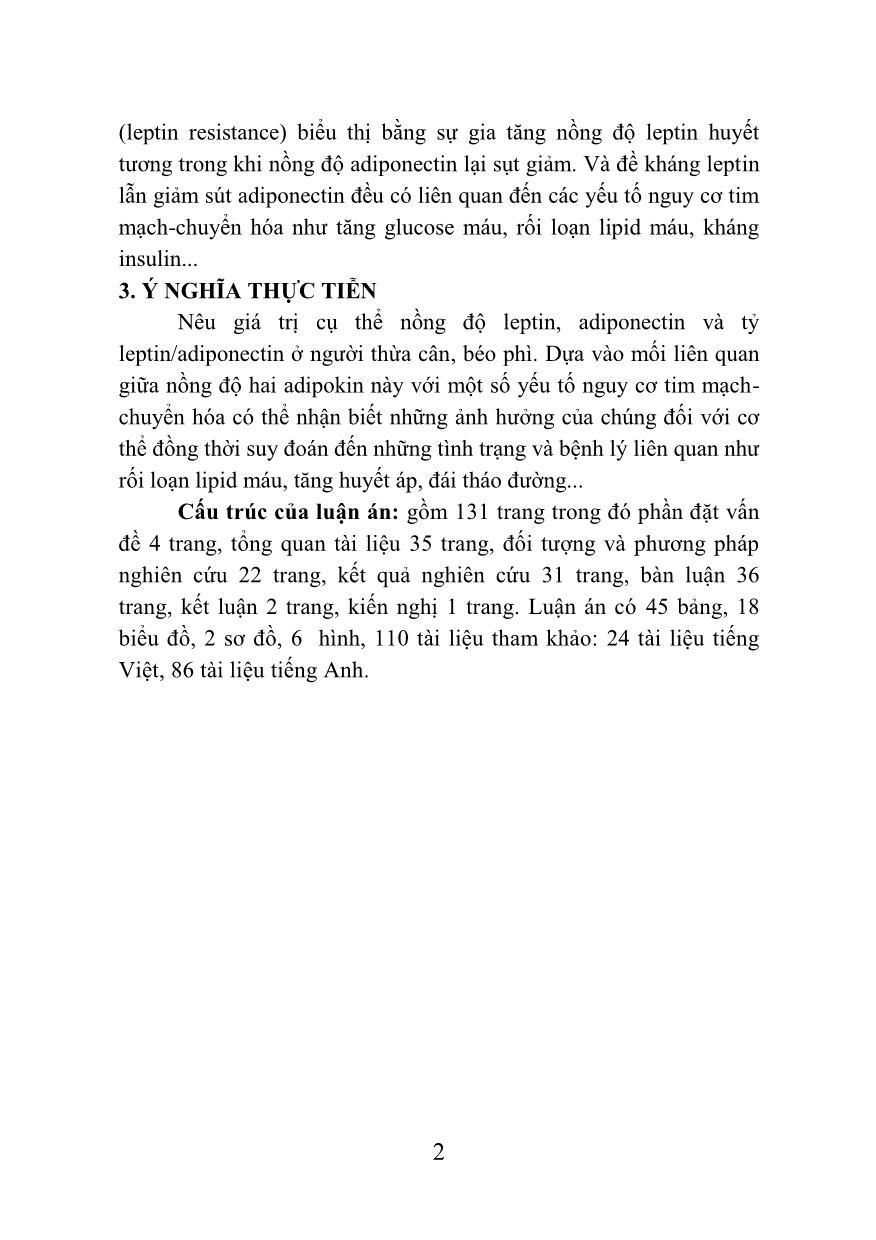
Trang 4
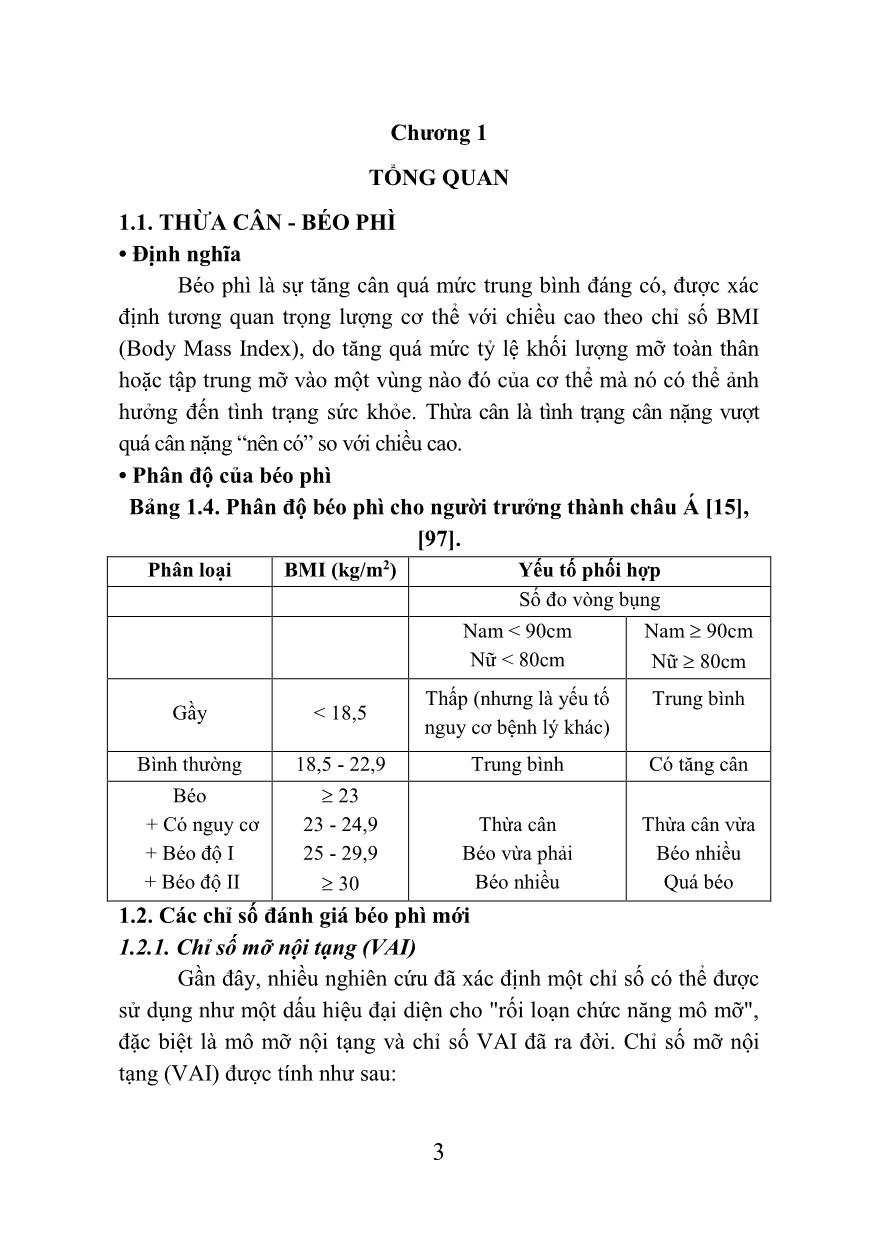
Trang 5
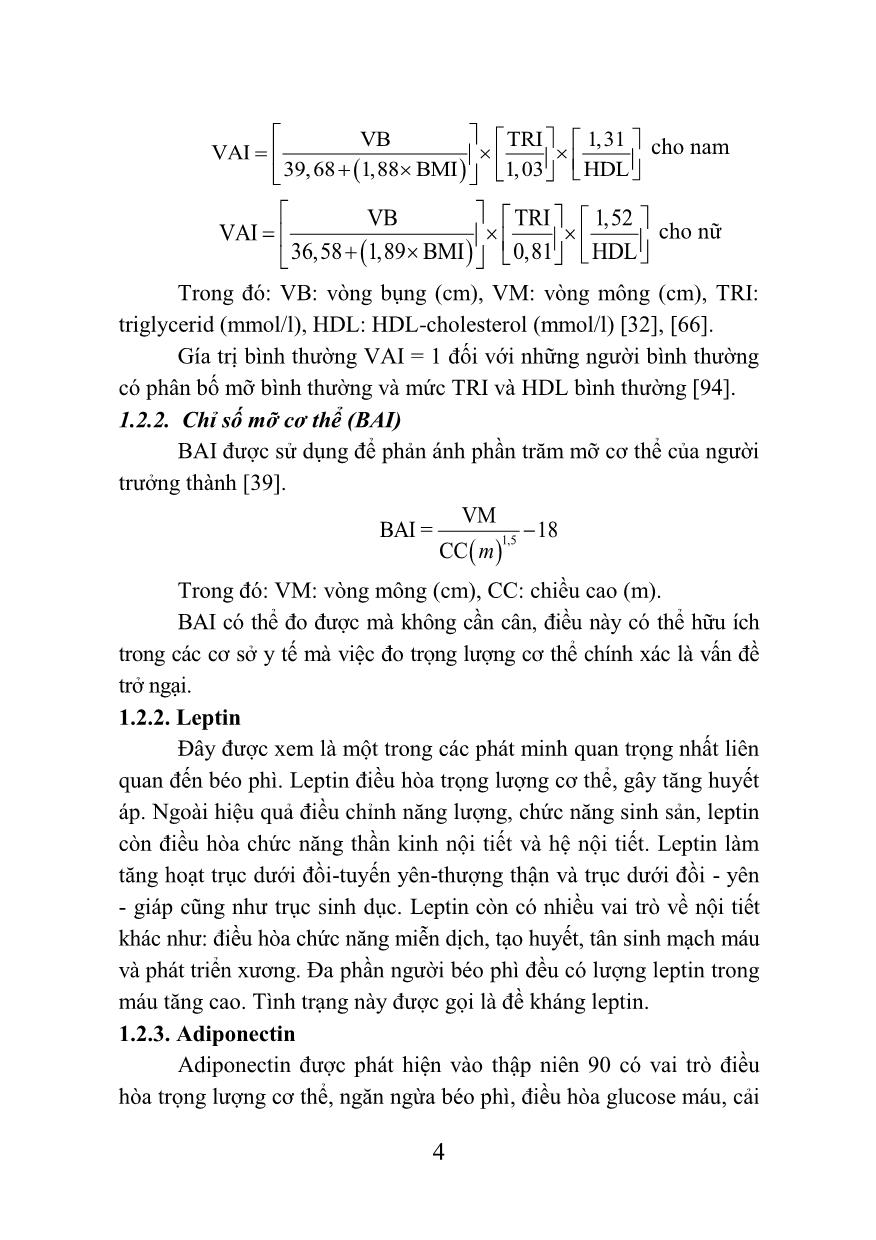
Trang 6
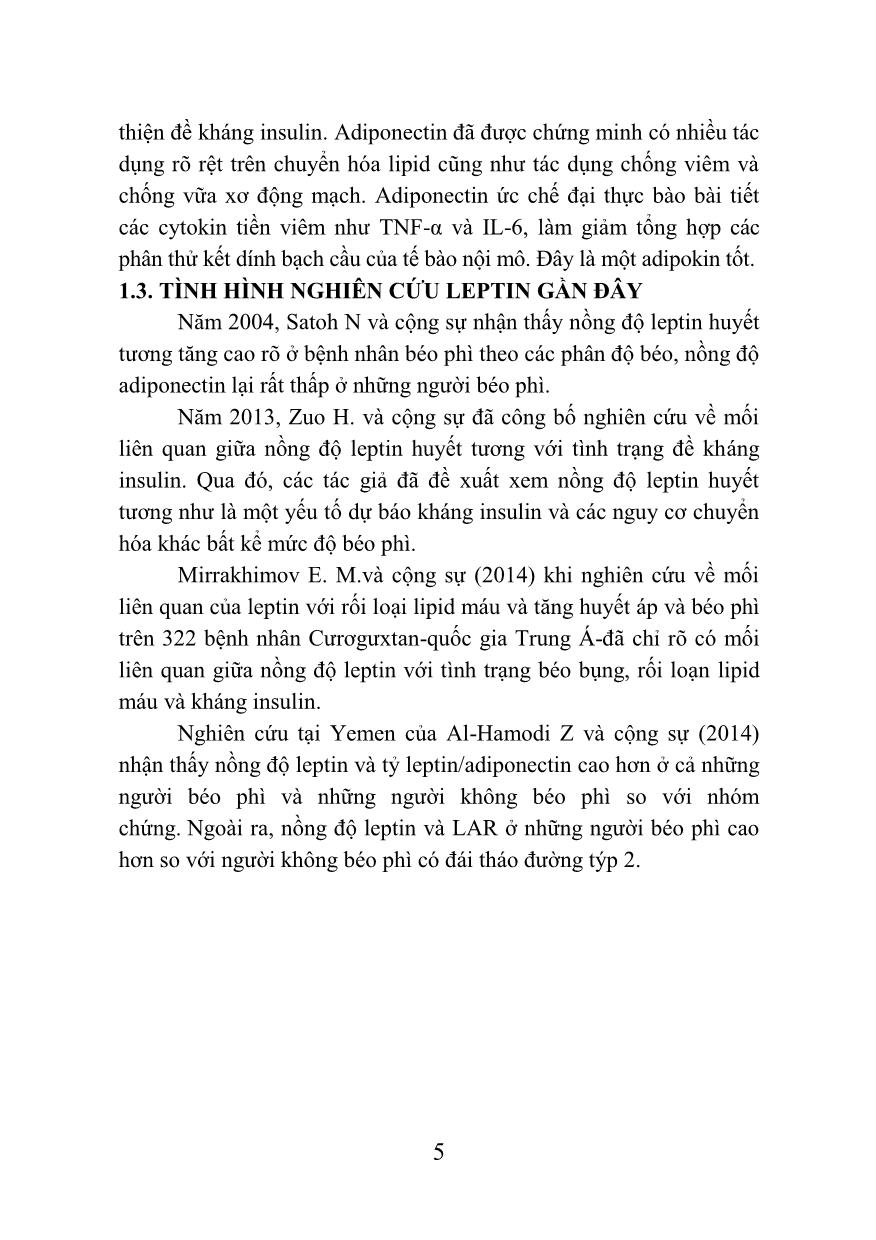
Trang 7
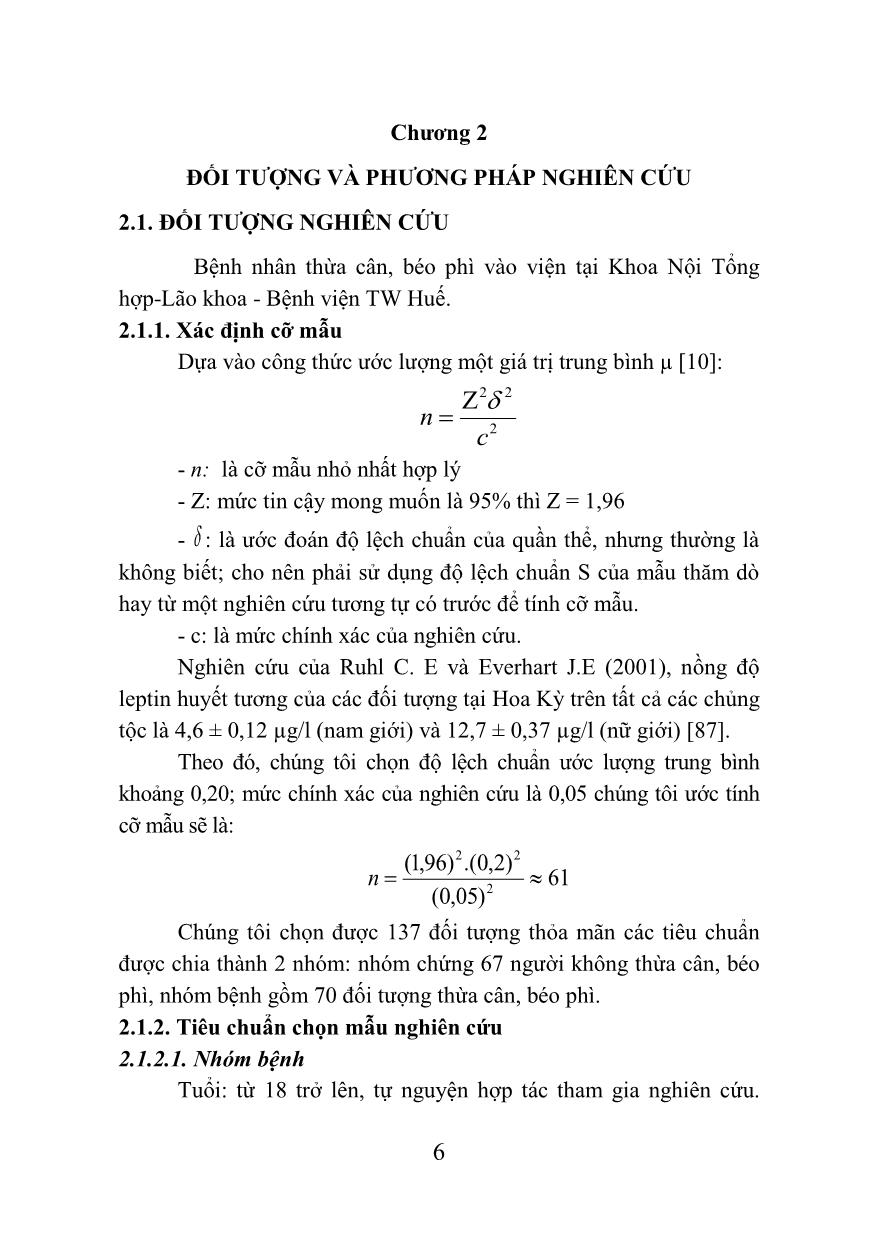
Trang 8
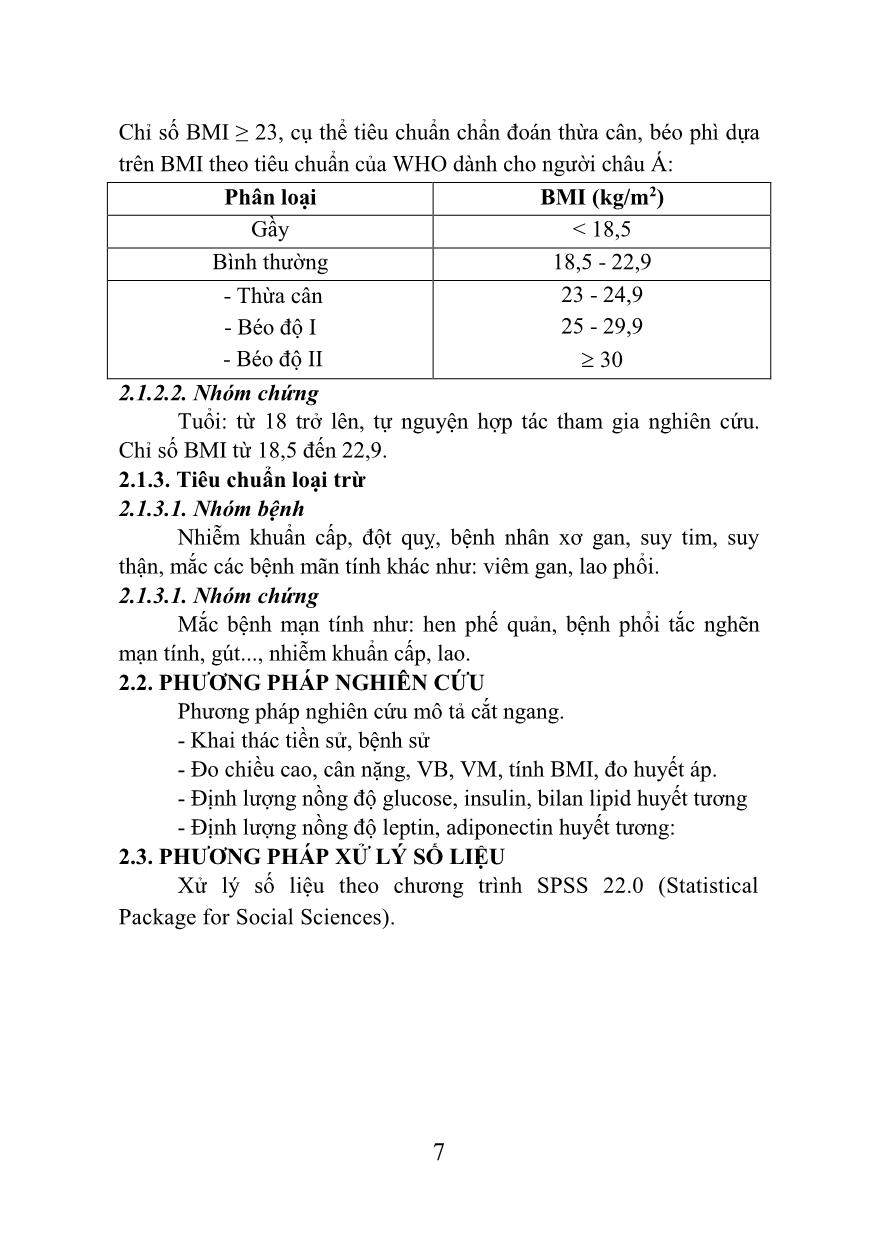
Trang 9
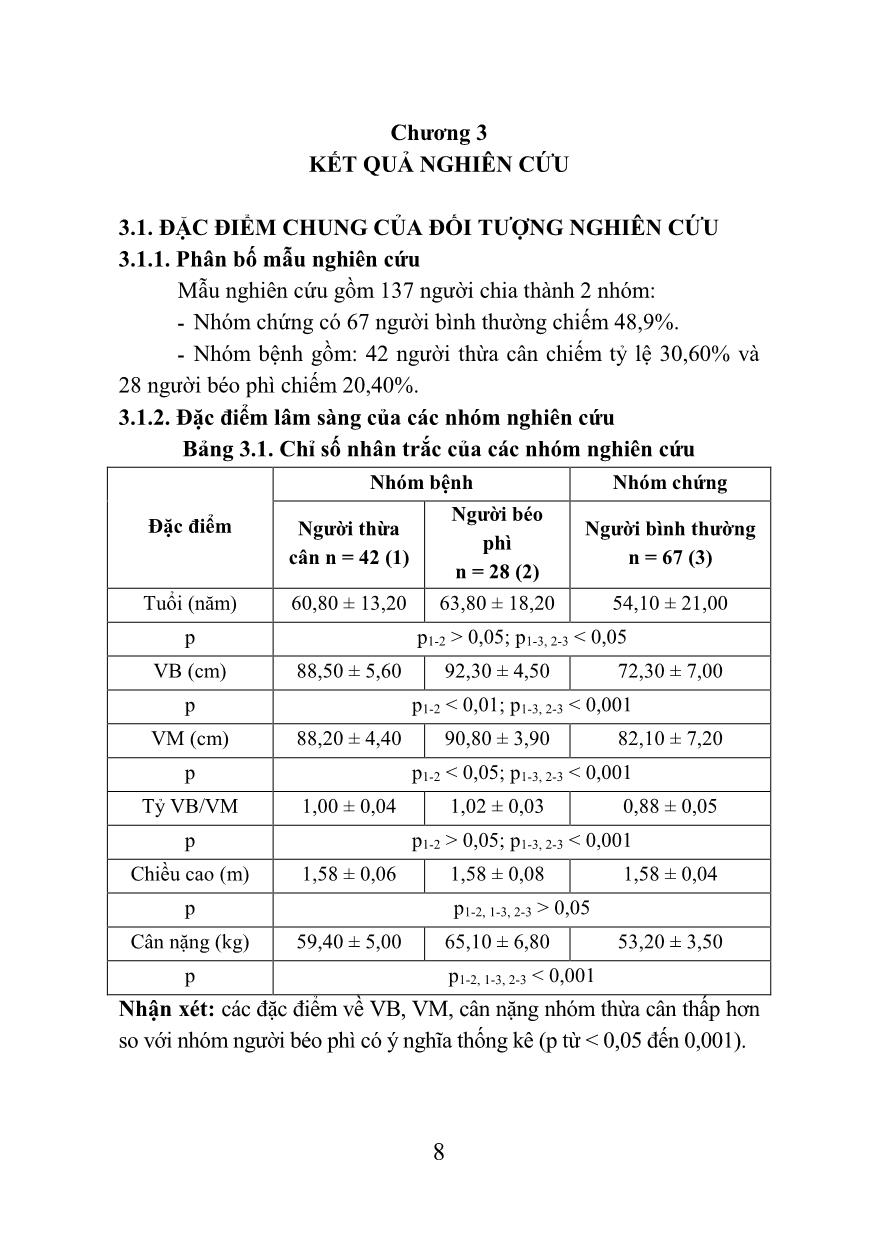
Trang 10
Tải về để xem bản đầy đủ
Tóm tắt nội dung tài liệu: Tóm tắt Luận án Nghiên cứu nồng độ leptin, adiponectin huyết tương và tỷ leptin / adiponectin trên đối tượng thừa cân - Béo phì
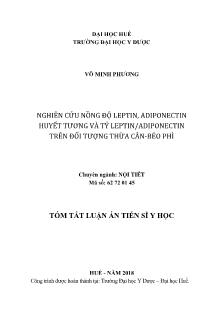
ĐẠI HỌC HUẾ TRƯỜNG ĐẠI HỌC Y DƯỢC VÕ MINH PHƯƠNG NGHIÊN CỨU NỒNG ĐỘ LEPTIN, ADIPONECTIN HUYẾT TƯƠNG VÀ TỶ LEPTIN/ADIPONECTIN TRÊN ĐỐI TƯỢNG THỪA CÂN-BÉO PHÌ Chuyên ngành: NỘI TIẾT Mã số: 62 72 01 45 TÓM TẮT LUẬN ÁN TIẾN SĨ Y HỌC HUẾ - NĂM 2018 Công trình được hoàn thành tại: Trường Đại học Y Dược – Đại học Huế. Người hướng dẫn khoa học: GS.TS. TRẦN HỮU DÀNG PGS.TS. NGUYỄN THỊ NHẠN Phản biện 1: ...................................................................................... ...................................................................................... Phản biện 2: ...................................................................................... ...................................................................................... Phản biện 3: ...................................................................................... ...................................................................................... Luận án sẽ được bảo vệ tại Hội đồng chấm luận án cấp Đại học Huế họp tại .................................................................................................... Vào hồigiờngàytháng.năm .................................. Có thể tìm hiểu luận án tại thư viện: ..................................................... 1 ĐẶT VẤN ĐỀ I. TÍNH CẤP THIẾT CỦA ĐỀ TÀI Leptin là một trong những adipokin được phát hiện đầu tiên của mô mỡ và khẳng định vai trò quan trọng của mô mỡ là một cơ quan nội tiết. Leptin giúp điều hòa sự trao đổi chất trong cơ thể bằng cách kích thích sự tiêu hao năng lượng, ức chế ăn vào. Trong hầu hết các trường hợp béo phì, tình trạng đề kháng leptin biểu hiện ở sự gia tăng nồng độ leptin huyết tương đã làm giới hạn hiệu quả sinh học của nó. Trái ngược với leptin, sự tiết adiponectin thường bị suy giảm trong béo phì. Adiponectin làm tăng sự nhạy cảm với insulin, oxy hóa acid béo cũng như tiêu hao năng lượng và làm giảm lượng glucose trong gan. Đây là hai sản phẩm bài tiết quan trọng của mô mỡ có vai trò gần như đối lập nhau. Adiponectin là chất bảo vệ còn leptin có tác dụng tấn công. Biến đổi nồng độ của 2 chỉ số trên đều liên quan với một số yếu tố nguy cơ tim mạch, chuyển hóa. Chính vì vậy khảo sát nồng độ leptin, adiponectin ở bệnh nhân thừa cân, béo phì là đề tài có cơ sở khoa học và lý luận chuyên ngành, một hướng nghiên cứu mới đang được quan tâm. II. MỤC TIÊU NGHIÊN CỨU 1. Xác định nồng độ leptin, adiponectin huyết tương và tỷ leptin/adiponectin trên đối tượng thừa cân, béo phì. 2. Đánh giá mối liên quan giữa nồng độ leptin, adiponectin huyết tương và tỷ leptin/adiponectin với một số yếu tố nguy cơ trên đối tượng thừa cân, béo phì qua đó xác định điểm cắt của các chỉ số nhân trắc để dự báo nồng độ leptin, adiponectin huyết tương và tỷ leptin/adiponectin. III. Ý NGHĨA KHOA HỌC VÀ THỰC TIỄN 1. Ý NGHĨA KHOA HỌC Ở người béo phì, có sự gia tăng nồng độ leptin huyết tương qua nhiều nghiên cứu, các tác giả gọi đây là sự đề kháng leptin 2 (leptin resistance) biểu thị bằng sự gia tăng nồng độ leptin huyết tương trong khi nồng độ adiponectin lại sụt giảm. Và đề kháng leptin lẫn giảm sút adiponectin đều có liên quan đến các yếu tố nguy cơ tim mạch-chuyển hóa như tăng glucose máu, rối loạn lipid máu, kháng insulin... 3. Ý NGHĨA THỰC TIỄN Nêu giá trị cụ thể nồng độ leptin, adiponectin và tỷ leptin/adiponectin ở người thừa cân, béo phì. Dựa vào mối liên quan giữa nồng độ hai adipokin này với một số yếu tố nguy cơ tim mạch- chuyển hóa có thể nhận biết những ảnh hưởng của chúng đối với cơ thể đồng thời suy đoán đến những tình trạng và bệnh lý liên quan như rối loạn lipid máu, tăng huyết áp, đái tháo đường... Cấu trúc của luận án: gồm 131 trang trong đó phần đặt vấn đề 4 trang, tổng quan tài liệu 35 trang, đối tượng và phương pháp nghiên cứu 22 trang, kết quả nghiên cứu 31 trang, bàn luận 36 trang, kết luận 2 trang, kiến nghị 1 trang. Luận án có 45 bảng, 18 biểu đồ, 2 sơ đồ, 6 hình, 110 tài liệu tham khảo: 24 tài liệu tiếng Việt, 86 tài liệu tiếng Anh. 3 Chương 1 TỔNG QUAN 1.1. THỪA CÂN - BÉO PHÌ • Định nghĩa Béo phì là sự tăng cân quá mức trung bình đáng có, được xác định tương quan trọng lượng cơ thể với chiều cao theo chỉ số BMI (Body Mass Index), do tăng quá mức tỷ lệ khối lượng mỡ toàn thân hoặc tập trung mỡ vào một vùng nào đó của cơ thể mà nó có thể ảnh hưởng đến tình trạng sức khỏe. Thừa cân là tình trạng cân nặng vượt quá cân nặng “nên có” so với chiều cao. • Phân độ của béo phì Bảng 1.4. Phân độ béo phì cho người trưởng thành châu Á [15], [97]. Phân loại BMI (kg/m2) Yếu tố phối hợp Số đo vòng bụng Nam < 90cm Nữ < 80cm Nam 90cm Nữ 80cm Gầy < 18,5 Thấp (nhưng là yếu tố nguy cơ bệnh lý khác) Trung bình Bình thường 18,5 - 22,9 Trung bình Có tăng cân Béo + Có nguy cơ + Béo độ I + Béo độ II 23 23 - 24,9 25 - 29,9 30 Thừa cân Béo vừa phải Béo nhiều Thừa cân vừa Béo nhiều Quá béo 1.2. Các chỉ số đánh giá béo phì mới 1.2.1. Chỉ số mỡ nội tạng (VAI) Gần đây, nhiều nghiên cứu đã xác định một chỉ số có thể được sử dụng như một dấu hiệu đại diện cho "rối loạn chức năng mô mỡ", đặc biệt là mô mỡ nội tạng và chỉ số VAI đã ra đời. Chỉ số mỡ nội tạng (VAI) được tính như sau: 4 VB TRI 1,31 VAI 39,68 1,88 BMI 1,03 HDL cho nam VB TRI 1,52 VAI 36,58 1,89 BMI 0,81 HDL cho nữ Trong đó: VB: vòng bụng (cm), VM: vòng mông (cm), TRI: triglycerid (mmol/l), HDL: HDL-cholesterol (mmol/l) [32], [66]. Gía trị bình thường VAI = 1 đối với những người bình thường có phân bố mỡ bình thường và mức TRI và HDL bình thường [94]. 1.2.2. Chỉ số mỡ cơ thể (BAI) BAI được sử dụng để phản ánh phần trăm mỡ cơ thể của người trưởng thành [39]. 1,5 VM BAI = 18 CC m Trong đó: VM: vòng mông (cm), CC: chiều cao (m). BAI có thể đo được mà không cần cân, điều này có thể hữu ích trong các cơ sở y tế mà việc đ ... on was proportional to BAI, r = 0,260 (p <0,05). 3.3.3. Relationship between leptin/ adiponectin ratio with risk factors Chart 3.9. Correlation between leptin/adiponectin ratio and BMI Remark: leptin/adiponectin ratio was proportional to BMI, r = 0,298 (p < 0,01). Chart 3.10. Correlation between leptin/adiponectin ratio and HOMA-IR Remark: leptin/adiponectin ratio was proportional to HOMA-IR, r = 0,298 (p < 0,01). 3.3.4. Determinate the cutoff points of anthropometric indices (WC, WC/HC ratio, BMI) predicted increase in leptin concentration y = 0,2598x + 24,261 r² = 0,0886 20,000 25,000 30,000 000 005 010 015 B M I leptin/adiponectin y = 0,5822x + 1,1024 r² = 0,3172 ,000 5,000 10,000 15,000 000 002 004 006 008 010 012H O M A -I R leptin/adiponectin Specificity S en si ti v it y 16 Chart 3.11. ROC curve predicts leptin concentration Table 3.14. Cutoff point VB, VB/VM, BMI predicted increase in leptin concentration Index Cutoff point AUC 95% Confidence interval p Sensitivity Specificity WC 89 0,697 0,576-0,801 < 0,01 55,17 85,37 WC/HC ratio 0,99 0,618 0,494-0,731 <0,05 51,72 75,61 BMI 24,78 0,522 0,399-0,643 >0,05 55,17 58,54 - VB has cutoff point was 89; The AUC = 0,697 estimated leptin increase, with CI = 0,576-0,801, the difference was statistically significant (p < 0,01), sensitivity was 55,17% and specificity 85,37%. - VB/VM has a cutoff point was 0,99; AUC = 0,618 estimated leptin increase, with CI = 0,496-0.731, (p < 0,05), sensitivity was 51,72% and specificity was 75,61%. 17 Chapter 4 DISCUSS 4.1. GENERAL CHARACTERISTICS OF RESEARCH SUBJECTS 4.1.1. Sample distribution Our study sample included 137 subjects satisfied the criteria were divided into two groups: a control group with 67 normal people accounting for 48,9%. Control group was a group of subjects with normal weight that could satisfy the age requirement of 18 and older, BMI of 18,5 to 22,9. Experimental group included 42 overweight subjects for 30,6% and 28 obese subjects accounted for 20,4% 4.1.2. Clinical characteristics of the study groups 4.1.2.1. Distribution ratio of overweight, obesity In our study, the overall obese ratio was 20.4% higher than the study of Le Bach Mai and colleagues 16.3% but lower than ratio reported by Kelly T and colleagues 23,2%, lower than the study of Tran Thua Nguyen 24,37%. 4.1.2.2. Anthropometric index of the study groups Compared with the domestic research, the BMI of our obese group: 26,18 ± 1,0 equivalent to Tran Thua Nguyen’s study 27,22 ± 1,39 in class I obese group. The overweight group had the BMI: 23,8 ± 0,6, also equivalent to Tran Thua Nguyen’s study 23,91 ± 0,49. The BMI in our obese group was 26,18 ± 1,0 higher than the study of Dao Thi Dua and Nguyen Hai Thuy 24,49 ± 0,94 4.1.2.3. Other obese indicators of the study groups • Visceral adiposity index (VAI): Our study found that VAI in overweight group, obese insulin resistance and obesity-free insulin resistance were higher than control group: 4,57 ± 3,8; 4,04 ± 3,24 vs. 2,27 ± 1,18 with p < 0,001. Our study has VAI consistent with Stępień M. Although VAI is not a diagnostic tool for cardiovascular and cerebrovascular disease , but VAI can be a useful tool in daily clinical 18 practice and in community studies to assess the metabolic risk associated with abdominal obesity. • Body adiposity index (BAI): Bergman R. N and colleagues (2011) are pioneers in the study of the proposed BAI formula by the BetaGene study. BAI values obtained in our study also found in similar studies of foreign authors. 4.1.3 Biochemical indices in the study groups 4.1.3.1. Dyslipidemia in overweight-obese patients The values of lipid in our study groups ảe generally equivalent to the authors as Tran Hue Nguyen, Nguyen Kim Luu. The prevalence of dyslipidemia in our obese group: total hypercholesterolemia was 60,7%; hypertriglyceridemia 42,9%; decreased HDL-C by 14,3% and increased LDL-C by 50% in accordance with local authors. 4.1.3.2. Insulin-hungry concentration of study groups Our blood insulin levels were: highest in obese group 11,17 ± 5,97 μU/ml, overweight group 9,44 ± 6,03 μU/ml and lowest in control group 6,46 ± 3,67 μU/ml, difference was statistically significant; p < 0,01. Another study by Mahadik S. R. (2012), high insulin levels in the obese group 25 μU/ml (20-38.5) compared with the control group 20 μU/ml (16-25); p < 0,001. 4.1.4. Indirect indices determine insulin resistance 4.1.4.1. HOMA-IR In the control group, the HOMA-IR index was 1,3 ± 0,75. This value is lower than Nguyen Cuu Loi by 3,83 ± 1,34; Nguyen Kim Luu 1,71 ± 0,15; Dao Thi Dua 3,40 ± 1,44. The HOMA-IR index on Al-Daghri N. M overweight subjects were significantly higher than our study 2,44 ± 1,84. This may be due to differences in race, overweight-obese selection criteria that was not applicable to Asians. 4.1.4.2. QUICKI 19 We also noted that the QUICKI index in the overweight-obese group was lower than the control group had a statistically significant. 0,89 ± 0,14 and 0,85 ± 0,11 compared to 1,0 ± 0,13; p < 0,001. This is in line with other domestic studies by Nguyen Kim Luu and Tran Thua Nguyen. 4.2. LEPTIN, ADIPONECTIN CONCENTRATION, LEPTIN/ADIPONECTIN RATIO OF OVERWEIGHT-OBESE SUBJECTS 4.2.1. Plasma leptin concentration We obtained the leptin concentration in the overweight-obese group by gender: 14,84 ± 3,44 ng/ml for females and 4,85 ± 1,37 ng/ml for males, difference was statistically significant, p < 0,001. Leptin concentration in the male overweight-obese group was also higher than the control group, 4,85 ± 1,37 ng/ml compared to 4,22 ± 3,82 ng/ml, p < 0,001. In the female overweight-obese group was also higher than control group, 14,84 ± 3,44 ng/ml compared to 8,92 ± 5,67; p < 0,001. This finding is not different from the study of Adami G. F and colleagues (2002) in Italy. 4.2.2. Plasma adiponectin concentration In 2011, Tran Khanh Chi and colleagues reported that adiponectin concentration in the group of female patients with type 2 diabetes were higher than in male but the difference was not significant; p > 0,05, adiponectin concentration in overweight and obese patients are lower than normal weight patients. The value of adiponectin concentrations in our study also suggests that these findings are consistent 4.2.3. Leptin/adiponectin ratio of overweight-obese subjects In our study, the leptin/adiponectin ratio in the overweight- obese group was higher than the control group, with a specific value of 2,53 ± 2,0; 1,58 ± 1,2; 1,86 ± 0,77 (p < 0,001 to 0,05). Our 20 estimate of the value of leptin/adiponectin ratio is similar to the study of Kappelle P. J. W. H and colleagues (2012). 4.3. RELATIONSHIP BETWEEN LEPTIN, ADIPONECTIN CONCENTRATION, LEPTIN / ADIPONECTIN RATIO WITH RISK FACTORS 4.3.1. Relationship between leptin concentration with risk factors 4.3.1.1. Correlation between leptin concentration with adiponectin concentration Unlike leptin, adiponectin concentration decrease in obese individuals. This is consistent with studies by foreign authors such as Al-Hamodi Z et al (2014) who reported negative correlations of leptin concentrations with adiponectin concentrations in obese people (r = - 0,216; p = 0,002). 4.3.1.4. Correlation between leptin concentration with HOMA-IR Al-Hamodi Z and colleagues (2014) reported a positive correlation between leptin concentrations and HOMA-IR [29]. Chou H. H and colleagues (2014) also reported a strong correlation between leptin concentrations and HOMA-IR. Our study yielded similar results to these authors. We found that, in the overweight- obese group, leptin concentrations were proportional to HOMA-IR (p < 0,01). 4.3.2. Relationship between adiponectin concentration with risk factors 4.3.1.1. Correlation between adiponectin concentration with waist circumference Study of Mahadik S. R and colleagues, India (2010), adiponectin concentration inversely correlates with the waist circumference. Our results also showed that the adiponectin concentration was inversely correlated to the waist circumference (r = -0,309; p < 0,01). 21 4.3.1.1. Correlation between adiponectin concentration with BMI The study by Nguyen Kim Luu (2012) showed that adiponectin concentrations were inversely correlated to BMI (r = - 0,256, p < 0,001). Mente A and colleagues noted from their study that plasma adiponectin concentrations were inversely correlated with BMI in the European communities, Chinese communities in Canada and indigenous people. We have also noted similar correlations as these authors (r = -0,237, p <0,05). 4.3.3. Relationship between leptin/ adiponectin ratio with risk factors 4.3.3.1. Correlation between leptin/adiponectin ratio with HOMA- IR We recorded that leptin / adiponectin ratio were proportional to HOMA-IR with r = 0,422; p < 0,01. This result is consistent with studies by foreign authors. Typically study of H. H Chou and colleagues found that the obese have leptin/adiponectin ratio positive correlated with HOMA-IR (r = 0,567; p <0,001). 4.3.3.2. Correlation between leptin/adiponectin ratio with cholesterol concentration When analyzing the correlation between leptin/adiponectin ratio and risk factors, we found that leptin/adiponectin ratio correlated positively with cholesterol and triglyceride concentration in male overweight-obese group (p <0,05 ). In their study, Satoh N and colleagues suggested leptin / adiponectin ratio as an atherogenic index rather than leptin or adiponectin alone. However, the authors did not evaluate the correlation between leptin / adiponectin ratio and lipid profile. In the female overweight-obese group, we did not find correlation between leptin/adiponectin ratio and lipid profile. This may be because our sample size is not large enough. 22 CONCLUSION Through study on 137 patients, including 70 who are overweight, obese and 67 who are normal weight, we draw the following conclusions: 1. PLASMA LEPTIN, ADIPONECTIN CONCENTRATION AND LEPTIN/ADIPONECTIN RATIO OF OVERWEIGHT-OBESE SUBJECTS 1.1. Plasma leptin concentration - Plasma leptin concentration increased gradually from control group (6,75 ± 5,17 ng/ml) to overweight group (9,74 ± 5,76 ng/ml) and obese group (10,74 ± 5,61 ng/ml). This increase was statistically significant at p < 0,05. - There were 29 overweight-obese patients increased plasma leptin concentration accounted for 41,40%. 1.2. Plasma adiponectin concentration - Plasma adiponectin concentrations decreased gradually from control group (9,67 ± 5,06 ng/ml) to overweight group (7,81 ± 4,83 ng/ml) and obese group (5,87 ± 4,10 ng/ml). This decrease was statistically significant at p < 0,05. - There were 27 overweight-obese patients decreased plasma adiponectin concentration accounted for 38,60%. 1.3. Leptin/adiponectin ratio - Leptin/adiponectin ratio increased gradually from control group (0,86 ± 0,77) to overweight group (1,58 ± 1,20) and obese group (2,53 ± 1,97). This increase was statistically significant at p < 0,05. - There were 33 overweight-obese patients who had an increase in leptin/adiponectin ratio of 47,10%. 23 2. RELATIONSHIP BETWEEN LEPTIN, ADIPONECTIN CONCENTRATION, LEPTIN / ADIPONECTIN RATIO WITH RISK FACTORS 2.1. Relationship between plasma leptin concentration with risk factors - Leptin concentration was positively correlated with BAI, concentrations insulin, cholesterol, plasma LDL-C and HOMA-IR (p < 0,01 to 0,05). - Leptin concentration was inversely correlated with QUICKI (p < 0,05). 2.2. Relationship between plasma adiponectin concentration with risk factors Adiponectin concentration was proportional to VB, VM and BMI (p < 0,01-0,05). 2.3. Relationship between leptin/adiponectin ratio with risk factors - Leptin/adiponectin ratio was positively correlated with BMI, plasma glucose concentration and HOMA-IR (p < 0,01). - Leptin/adiponectin ratio was inversely correlated with QUICKI (p < 0,01). 2.4. Determinate the cutoff points of VB, VB/VM ratio, BMI - VB has cutoff point at 89; area under curves (AUC) 0,697 predicted increase in leptin concentration with confidence interval (CI) 0,576-0,801; p < 0,01; sensitivity was 55,17% and specificity was 85,37% - VB/VM ratio has cutoff point at 0,99; AUC = 0,618 predicted increase in leptin concentration with CI 0,496-0,731; p < 0,05; sensitivity was 51,72% and specificity was 75,61%. 24 PETITIONS Need to continue studying the concentration of leptin, adiponectin, leptin/adiponectin ratio in overweight-obese patients with larger sample sizes, especially with class I obesity or above as a basis for assessing the indirect function of adipose tissue. Besides classic obesity indicators such as BMI, waist circumference, hip circumference, waist/hip ratio; new indicators such as visceral adipose index (VAI), body fat index (BAI) have shown the benefits that should be studied more.. Recommended leptin/adiponectin ratio is a new indicator for assessing insulin resistance in addition to common indicators such as HOMA-IR and QUICKI. LIST OF RESEARCHES CORRELATING WITH MY STUDY - "Study on plasma leptin and adiponectin concentration in overweight - obese", Journal of Medicine and Pharmacy - Hue University of Medicine and Pharmacy, No. 28 + 29/2015. - "Assessing the association between leptin, adiponectin concentration, hs-CRP and obesity indicators in overweight- obese patients," Journal of Vietnamese Medicine, 8/2015.
File đính kèm:
 tom_tat_luan_an_nghien_cuu_nong_do_leptin_adiponectin_huyet.pdf
tom_tat_luan_an_nghien_cuu_nong_do_leptin_adiponectin_huyet.pdf

